Below is the complete list of seminar speakers for fall 2021. In-person seminars will be held at 106 Upson Hall. Please fill out the attached sign-up forms if you plan to attend the in-person seminars in fall. The virtual seminars are held via zoom.
August 31 (in-person)
Moran Bercovici, Israel Institute of Technology
Title: Fluidic Shaping of Optical Components on Earth and in Space
Abstract: I will present our theoretical and experimental work on leveraging the basic physics of liquid-fluid interfaces for fabrication of a wide range of high-quality optical components, without the need for any mechanical processing.
I will first discuss the use of light projection to create desired deformations in thin polymer films by the thermocapillary effect. Polymerization of the film results in diffractive optical elements with sub-nanometric surface quality.
To create larger components such as eyeglasses or telescope lenses, the elimination of gravity is crucial. Relying on neutral buoyancy, we developed a passive method wherein we engineer boundary conditions on fluidic interfaces to drive liquid volumes into minimum energy states that correspond to desired optical topographies.
Time permitting, I will discuss our collaboration with NASA on the use of this technology of in-space fabrication of optics and for the creation of large space telescopes that overcomes launch constraints.
September 7 (zoom)
José Alvarado, University of Texas at Austin
Title: Nonlinear flow response of soft hair beds
Abstract: We are ‘hairy’ on the inside: beds of passive fibres anchored to a surface and immersed in fluids are prevalent in many biological systems, including intestines, tongues, and blood vessels. These hairs are soft enough to deform in response to stresses from fluid flows. Yet fluid stresses are in turn affected by hair deformation, leading to a coupled elastoviscous problem that is poorly understood. Here we investigate a biomimetic model system of elastomer hair beds subject to shear-driven Stokes flows. We characterize this system with a theoretical model that accounts for the large-deformation flow response of hair beds. Hair bending results in a drag-reducing nonlinearity because the hair tip lowers towards the base, widening the gap through which fluid flows. When hairs are cantilevered at an angle subnormal to the surface, flow against the grain bends hairs away from the base, narrowing the gap. The flow response of angled hair beds is axially asymmetric and amounts to a rectification nonlinearity. We identify an elastoviscous parameter that controls nonlinear behaviour. Our study raises the hypothesis that biological hairy surfaces function to reduce fluid drag. Furthermore, angled hairs may be incorporated in the design of integrated microfluidic components, such as diodes and pumps.
September 14 (in-person/zoom)
Jessica Shang, University of Rochester 
Title: Measuring the viscosity of high energy-density fluids
Abstract:The mixing and transport of fluids at high pressures and temperatures can be found in applications ranging from planetary interiors to inertial confinement fusion. Modeling shows that the evolution of such flows are significantly altered when microphysical transport processes such as viscosity are explicitly included. However, despite the impact that viscosity has on the formation and growth of hydrodynamic instabilities and turbulence, experimental measurements of viscosity of materials at high energy-density conditions are limited in parameter space. Few viscometry techniques can be applied at high pressure; some can be applied to fluids that have been statically compressed (<10 GPa), and fewer still can be applied dynamically (>100 GPa). In this talk, we discuss ongoing experimental and modeling campaigns at advanced laser facilities to determine viscosity in dynamically compressed fluids using two different techniques. In the first experiment, we used x-ray radiography to measure the displacement of impulsively accelerated spheres in plastic, and compared these with unsteady forcing models that include viscous effects. In the second proposed experiment, viscosity will be deduced by measuring the evolution of a perturbed shock front with velocity interferometry. Unraveling the role of viscosity will improve hydrodynamic modeling for these complex systems and guide the development of particle-based velocimetry.
September 21 (zoom)
Laura Miller, University of Arizona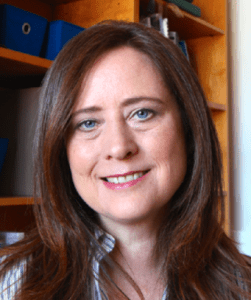
Title: Flow through the hairy appendages of small animals: The leaky rake to solid plate transition
Abstract: Numerous small organisms that swim, fly, smell, or feed in flows at the mesoscale, where inertial and viscous forces are balanced, use branched, bristled and hairy structures. Such mesoscale structures can augment underlying biological function (e.g., particle capture) by moving in a manner that transitions from acting as solid surfaces to leaky at Reynolds number close to one. Although mesoscale flows have been studied in many organisms, the fluid dynamic mechanisms underlying the leaky rake to solid plate transition remain unclear, and robust mathematical models are unavailable. I will present results from numerical simulations and experiments that demonstrate how these transitions affect locomotion, feeding, and exchange. Examples will include filtering flows through upside down jellyfish oral arms, airflows through bristled insect wings, exchange flows through corals, and sampling flows in crabs. In particular, the immersed boundary method will be used to resolve the flow through moving, flexible and porous structures.
September 28 (zoom)
Yoshiyuki Tagawa, Tokyo University of Agriculture and Technology
Title: Focused jets and cavitation caused by large acceleration
Abstract: Liquid jets and cavitation are found in various flows, e.g. printing processes and biological/medical systems. This seminar introduces focused jets (their tip diameter much smaller than capillary nozzle) and cavitation caused by a large acceleration via impulsive forces. We invented a simple device to generate a highly-viscous jet of 10,000 mm2/s, which is as viscous as honey. The fluid dynamics behind is elucidated by dividing the jet generation process into three parts that occur in different time scales; propagation of pressure waves in the acoustic interval, the liquid accelerates due to the impact in the impact interval, and the liquid jet emerges via flow focusing in the focusing interval. Interestingly, the onset of cavitation caused by acceleration if found to enhance the jet velocity twice as fast as the jet velocity without cavitation. The threshold of acceleration-induced cavitation is derived from the equation of motion. Finally, for practical use of the jets, preformed bubbles in the liquid is used to control the cavitation effect on the jet velocity.
October 5 (zoom)
Bhargav Rallabandi, University of California Riverside
Title: Sliding along slippery soft surfaces
Abstract: Fluids interact with soft structures in many natural and engineered systems including blood flow, peristalsis, and microfluidic applications. This talk focuses on how confinement by soft surfaces shapes the motion of objects suspended in the fluid. In the first part of my talk, I will present experiments demonstrating that particles settling near a flexible elastic membrane are repelled by it due to hydrodynamic interactions. This repulsion is understood quantitatively using a theory that combines the tension and bending rigidity of the membrane with the fluid flow. I will then show how these ideas can be generalized to other elastic responses, and how they can be employed in non-contact measurements of the mechanical properties of soft materials. The second part of my talk introduces a setting where a tightly fitting object moves through an elastic fluid-filled tube. I will introduce a nonlinear lubricated membrane theory that couples the fluid flow to the stretching elasticity of the tube. We discuss how hoop stresses due to radial stretching and membrane tension caused by axial stretching of the tube shape the flow, drawing analogies with Bretherton’s problem of bubbles moving through capillaries. We discuss the implications of these findings on peristaltic pumping of suspended particles through soft tubes. .
October 12 (zoom)
Chris MacMinn, University of Oxford
Title: Fluid-fluid phase separation in a soft porous medium
Abstract: The interactions of two fluids within a porous medium depend strongly on flow conditions, wettability, and the structure of the pore space. At the pore scale, these interactions are characterised by the formation of wetting films that coat solid surfaces and occupy corners and throats, and the formation of non-wetting blobs that occupy larger pore bodies. The invasion of non-wetting blobs into narrow throats is energetically unfavorable, but it can be forced with a sufficiently high pressure gradient. In a soft porous medium, where the pore structure can deform in response to the flow, the most striking feature of two-fluid-phase flow is the tendency of the non-wetting phase to enlarge the pore space by pushing the solid grains apart, to the point of forming macroscopic cavities in the medium. These cavities can be much larger than the pore scale, and they form spontaneously when the energetic benefit of reducing the Laplace pressure exceeds the energetic cost of deforming the solid skeleton. Here, we consider this process through the lens of phase separation, where a non-wetting phase separates (or not) from a fluid-fluid-solid mixture. Motivated by experimental observations, we construct a phase-field model in which two immiscible fluids interact with a poroelastic solid skeleton. Our model captures the competing effects of elasticity, confinement, flow, and fluid-fluid-solid interactions. We then use our model to consider an initial distribution of non-wetting fluid in the pore space that separates into multiple cavities. We identify the key parameters that control phase separation, the conditions that favor the formation of cavities, and the characteristic size of the resulting cavities. Our results have implications for a wide variety of natural and industrial systems, such as the nucleation and growth of gas bubbles in lake beds and waste ponds.
October 19 (zoom)
Emilie Dressaire, UC Santa Barbara
Title: Pushing boundaries: flow in low permeability media
Abstract: Generating and controlling fluid flow in low permeability environments is a challenge in natural and engineered systems. In this talk, I will discuss two studies involving the opening of fractures in a soft substrate and the clogging of microchannels. The injection of fluid in brittle elastic materials drive the formation of cracks. Besides, when the pressure is released, the fluid flows out of the crack, in a process called backflow. Using a model experiment, we characterize the growth of a disk-like crack that propagates upon injection of the fluid, and its collapse as the injection pressure is released. The viscous dissipation, elastic deformation, and toughness of the matrix are important physical parameters that control the fluid flow in the crack or blister. This strategy is commonly used in rocks of low permeability and could find applications in bioengineering.
Yet the increase in permeability is only transient. A solution to avoid the closing of the crack formed by injection is to use suspensions of particles. However, the behavior of particles in confined systems remains mainly qualitative. I will discuss recent results obtained on the clogging of microchannels. When a suspension of particles flows in a microchannel, deposition and assembly can lead to the formation of a clog, followed by a stable aggregate of fixed porosity. I will present a model for the growth of the aggregate at the pore scale, which allows us to rationalize the evolution of the flow rate in networks of microchannels. Bridging the injection of fluid in elastic media with suspension dynamics is a promising route to advance printing in soft materials.
October 26 (zoom)
Henry Fu, University of Utah
Title: Physical constraints on the propulsion of microrobots
Abstract: Currently, artificially propelled magnetic micro- and nanoparticles are of interest for potential applications such as hyperthermic therapy, drug delivery, and microsurgery. Here, we focus on propulsion via rotation of rigid magnetic particles by an external magnetic field, which is attractive since it can be scaled down to micron sizes, and since magnetic fields permeate through many media including biological tissue. I will discuss our work exploring the fundamental physical constraints on this type of propulsion. By analogy with biological swimming, which is constrained by the kinematic reversibility of Stokes flow, it was expected that magnetically rotated micropropulsion required chiral geometries, like that of a helical bacterial flagellum. In contrast, we have shown that propulsion by magnetic rotation is possible for achiral geometries. Still, the propulsion of the simplest geometries, such as spheres, would seem to be prohibited by fore-aft symmetry along the rotation axis. We have found that in nonlinearly viscoelastic fluids, a symmetry breaking propulsion is possible for rotating microspheres. Finally, most models of magnetically rotating microrobots assume a permanent magnetic moment, but actual magnetic materials have moments which depend on the externally applied field. We show that such magnetic response leads to limits on the propulsion velocity achievable by rotating propulsion.
November 2 (zoom)
Lin Fu, Hong Kong University of Science and Technology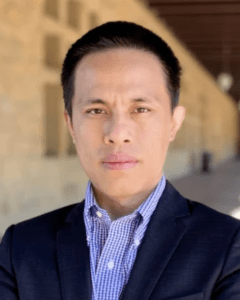
Title: Physics and modeling of hypersonic wall-bounded turbulence
Abstract: In this talk, we will focus on the physics and modeling of the hypersonic wall- bounded turbulence. Firstly, the interaction of an incident shock wave with a Mach-6 laminar boundary layer is addressed using DNS and equilibrium wall-modeled LES (WMLES). The consequences of the interaction are that the boundary layer transitions
to turbulence, and that transition causes a localized significant increase in the Stanton number and skin-friction coefficient. WMLES provides predictions of DNS peak loads within 10% at 150 times lower computational cost. In the fully-turbulent boundary layer, WMLES agrees well with DNS for the Reynolds-analogy factor, the mean velocity and temperature profiles, and the temperature/velocity correlations.
Secondly, we will present our recent efforts in modeling the wall-bounded turbulence. A new wall model accounting for pressure gradient and Reynolds number effects and a method for determining the boundary-layer thickness in complex flows are introduced. The extension to high-speed flows is accommodated by proposing a novel transformation, which maps the mean velocity profiles of compressible wall- bounded turbulent flows to the incompressible law of the wall. Unlike existing approaches, the proposed transformation successfully collapses, without specific tuning, numerical simulation data from fully developed channel and pipe flows, and boundary layers with or without heat transfer. The performance of the transformation is verified for compressible wall-bounded flows with edge Mach numbers ranging from 0 to 15 and friction Reynolds numbers ranging from 200 to 2000. Based on physical arguments, we show that such a general transformation (i.e., compressible law of the wall) exists for compressible wall-bounded turbulence regardless of the wall thermal condition (Ref. PNAS 2021, JFM 2021, PRF 2021, etc.).
November 9 (zoom)
Jesse Belden, Naval Undersea Warfare Center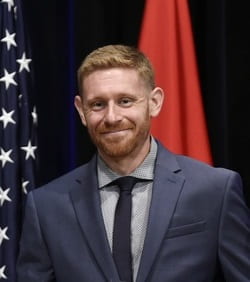
Title: Water entry: impact forces, cavity shapes and surprises at a free-surface
Abstract: The splash and air cavity formations following the impact of a disk on a free surface are well-documented. Such events are characterized by a sub-surface air cavity and an above surface splash crown that ultimately domes over and seals. If slight concave curvature is given to the face of the disk, forming a cup, then these phenomena can change quite dramatically, even resulting in cases that suppress cavity formation. In this talk, we examine the effect of this cupped geometry on the splash and cavity physics and suggest mechanisms responsible for the observed differences. Furthermore, we directly measure body accelerations in order to estimate instantaneous forces, and relate these measurements to high speed images of the cavity and splash phenomena. We then investigate sphere impact on a water surface that has been altered by a preceding jet. The jet of water creates a large subsurface cavity prior to impact of the sphere, which follows directly in its path. This method of “free-surface preparation” suppresses cavity formation at sphere impact velocities for which it would otherwise be expected. Additionally, it greatly diminishes the large initial impact force, and alters the forces after impact. We show reduction in the maximum impact force by 50-75% from the quiescent pool cases. Finally, this latter experiment led to the accidental discovery of beautiful thin film shapes that appear as a water jet exits a pipe. The film can morph into various forms including fluted champagne glasses, bubbles, bells, jets, and crowns. We experimentally examine the regimes of this phenomenon and attempt to elucidate the physics behind how and why they occur.
November 16
DFD Practice talks: Sanjit Basket, Sabyasachi Sen
November 30 (zoom)
Michelle Driscoll, Northwestern University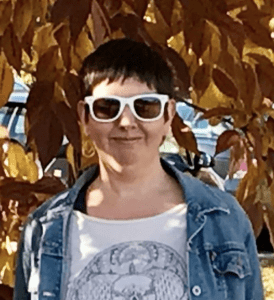
Title:Emergent Structure in Magnetic Microrollers
Abstract: Microrollers are rotating colloidal particles that become active close to a wall due to an asymmetric flow of the fluid around the particles. They can be experimentally realized by driving magnetic particles with a magnetic field rotating perpendicular to the wall. The velocity of a microroller is much slower than the velocity of the fluid pumped around it. Therefore, a particle put in the flow field around a microroller will have a velocity much higher than the microroller itself. This leads to strong collective effects where the average velocity of a suspension of microrollers increases as a function of the density. These collective effects lead to a rich array of emergent structure in this system, from shocks, to fingering patterns, to stable, hydrodynamically-bound clusters.
We study these emergent structures using a variety of computational and experimental techniques, including Stokesian dynamics simulations and a coupled magnetic-optical imaging system. We have also developed new techniques to study the detailed fluctuating structure of these suspensions in uniform flow. For example, at higher densities the particles form two layers: a slow one close to the wall and a much faster one above it. We study this layering structure in detail using a small fraction of tagged particles, and these results are complemented by high-resolution Brownian dynamics simulations that capture lubrication interactions.
Furthermore, we study the interaction of microrollers with a structured environment, for example a particle approaching a forest of obstacles in its path. Focusing on the model system of a single particle interacting with a single obstacle, we find a strong hydrodynamic trapping effect occurs in our experimental system, and we have used our simulation methods to characterize this trapping in detail. Finally, as we are using two-photon polymerization to manufacture the obstacles, we can begin to explore how our particles interact with fully 3D structures.
December 7 (zoom)
Pierre-Thomas Brun, Princeton University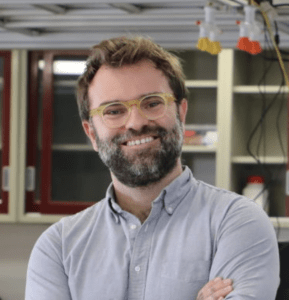
Title: Engineering interfacial flows and instabilities in solidifying liquids
Abstract:This talk is concerned with interfacial fluid mechanics in the context of solidifying liquids. Due to favorable downscaling with length, capillary effects are dominant for submillimetric objects and play a key role is a number of engineering and natural processes where they dictate the shape of drops, thin films, and coatings. As such, interfacial effects have been widely researched, albeit primarily in Newtonian fluids or in fluids whose constitutive law remains constant over time. In particular, the subtle interplay between hydrodynamics, solidification and the solid structures formed when harnessing capillary effects remain poorly understood. We will attempt to fill this gap of knowledge and study the physics of viscous jets and sheets in solidifying liquids. We will discuss experiments conducted with a model system, an elastomeric solution, so as to elucidate the competing phenomena at play in the formation of patterns and structures arising from interfacial flows and their subsequent or concomitant solidification. We will revisit classic fluid mechanics models, e.g. lubrication, and adapt them to situations where the flow is arrested in finite time. First, we will discuss droplet forming instabilities and show that patterns they form can be engineered via the use of templates. New phenomena, e.g. self-templating, will be explored too. Second, we will revisit classic coating, drainage and imbibition problems and demonstrate that these flows can be used for materials design, e.g. fabricate soft robots . In fact, curing converts the flows we study into elastic solids, introducing the concept of “building with flows”.
